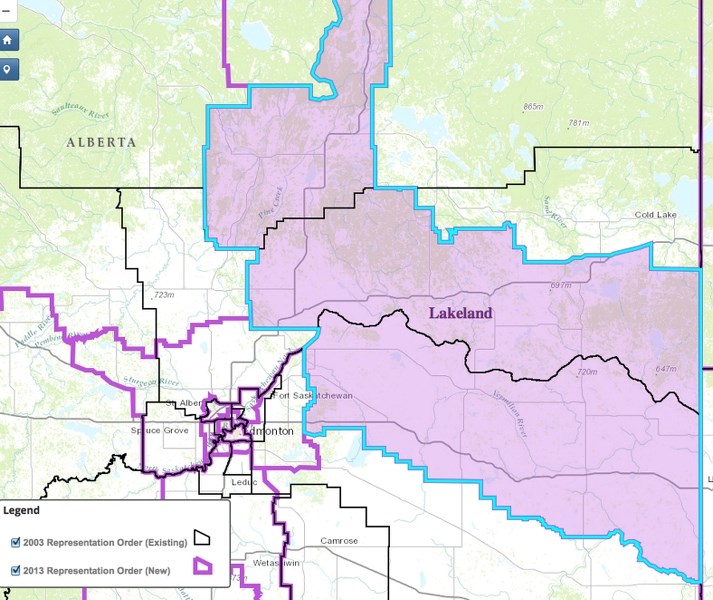The MD of Bonnyville will no longer be represented as a whole in the eyes of the federal government. Under the new federal riding boundaries Ardmore, Fort Kent and Cold Lake are being cut-off from Lakeland riding and grouped in the Fort McMurray – Cold Lake riding.
MD Reeve Ed Rondeau said it has yet to be seen whether the municipality being split up is a good thing or not.
“I would have been nice if the whole MD was in the same riding. People are a little confused and not very happy that the MD is split up in two different ridings,” said Rondeau. “It was kind of nice before because your MP covered the whole MD, but I think if you look at the positive side of it, it's probably going to be a good thing that you can chase down two MP's to go after the same request.”
Under the 2003 representation order, the Westlock – St. Paul riding encompassed everything from Cold Lake and south to the North Saskatchewan River. The riding ran to just west of Westlock including in it Redwater, Morinville and Gibbons.
The new 2013 representation order, which will be in affect once a general election is called, saw the inclusion of an official federal Lakeland riding. The northeastern most point of the new riding boundary, starts at the Saskatchewan border slightly north of the Elizabeth Metis Settlement. The boundary line then jumps up to run along Highway 28 just west of Ardmore, with everything south of the highway included in the Lakeland riding. West of Fort Kent, the Lakeland boundary line switches to run along highway 660. At the end of highway 660 (when it intersects with Range Road 93 northwest of Therien) the boundary line travels northwest to include areas such as St. Lina, Goodfish Lake, Kikino and Wandering River.
The new Lakeland riding boundary goes west to include Athabasca and ends just past Baptiste Lake. The boundary line then heads southeast to include Thorhild, but unlike the previous Westlock – St. Paul riding, separates Westlock and Redwater into their own ridings. The Lakeland continues south to include Elk Island National Park, Mundare and Vegreville. The south borderline then runs along Battle River where it ends at the Saskatchewan border.
“Every 10 years they do a census because Statistics Canada then has a better idea of the up to date population changes across the country,” explained Diane Benson of Elections Canada.
Benson added that those numbers are prepared for the chief electoral officer. He passes the information along to a judge and two others who have been appointed by the federal cabinet to form an independent commission. After creating the proposed boundaries, the commission conducts consultations and hearings across the country before presenting the final proposal to parliament.
“They propose where they think it makes even population marks because the goal across Canada is to have somewhat equal representation for members of parliament across the country,” said Benson.
The commission strives to divide up the federal boundaries so that each riding has the same population of approximately 100,000. This led to Alberta gaining six new seats under the redistribution, bringing the province's total seats in the House of Commons to 34 and warranting the creation of new ridings.
Due to the neighbouring riding including quickly growing cities like Cold Lake and Fort McMurray, Rondeau said he's not too concerned with the changes.
“I could be wrong but I think it's going to be a short term thing because otherwise there's going to be a lot greater population in (the Fort McMurray – Cold Lake) riding then,” expressed Rondeau.
He added, “By the time they get around to redoing it in 10 years, that riding is going to be way over so subsequently they're going to have to adjust the boundaries.”
With the Lakeland riding, amongst others, covering a vast amount of ground, federal Progressive Conservative candidate for the Lakeland riding Shannon Stubbs said it's going to be imperative for the next MP to represent their entire riding.
“I think it is critical for candidates, and for the next MP, to be available and accessible across the EDA and to travel as much as possible across the Lakeland,” said Stubbs.
Despite its size, Stubbs added that the communities in the Lakeland riding share the majority of the same concerns and values citing examples such as environmental and economic sustainability, the cost of living and skilled labour.
“The Lakeland is vast geographically but the communities and rural areas across the EDA share similar priorities and concerns. The sectors of agriculture and energy are the main economic drivers across the region and so the challenges are similar everywhere in the Lakeland.”
The redistribution process came to an end in October 2013 and saw 30 new ridings added across the country, as well as boundary changes for many other ridings. While they are proclaimed into law, the new federal riding boundaries won't come into affect until the next general election.



